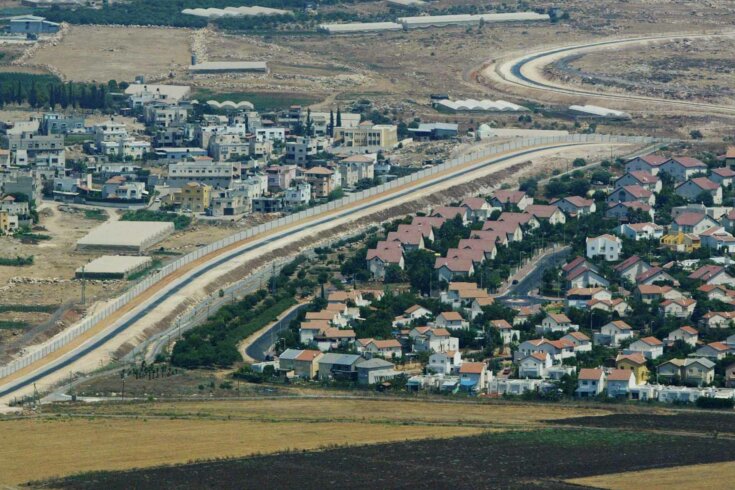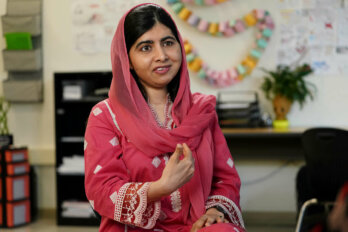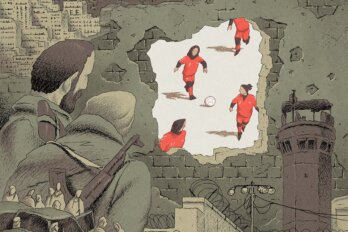“Canada’s position is crystal clear,” Prime Minister Justin Trudeau said this past January. “We believe the only way forward for the region, indeed the only way forward for a safe and secure Israel, is to have a Palestinian state that is also safe and secure with internationally recognized borders. We believe in a two-state solution.”
Prompted by the calamitous events in Gaza and Israel since Hamas’s attack on October 7, 2023, this position has been echoed by many world leaders, including US president Joe Biden and United Nations secretary-general António Guterres. Yet Western interests have pushed, unsuccessfully, the idea of two states for two peoples—one Jewish, one Palestinian—for more than seventy-five years. It’s not clear this time will be any different.
Although there has been increasing recognition of Palestinian statehood in recent weeks within the international community, this is largely a symbolic gesture rather than a meaningful step toward a two-state solution. The political will to create a Palestinian state is absent among all of Israel’s main political parties, and the idea is unpopular among both Palestinians and the Israeli Jewish population. Though the Palestinian Authority supports the idea of two states, the outfit has been greatly discredited by its corruption, incompetence, and collaboration with Israeli security services. It is despised by most Palestinians and has lost the legitimacy to represent them. As for Hamas, it has yet to recognize the state of Israel, even though it has accepted the notion of a Palestinian state with pre-1967 borders.
Given these barriers, and the fact that Western governments have not enacted policies that would have demonstrated their support for two states (such as more aggressively sanctioning against the expansion of West Bank settlements), the calls today for a Palestinian state alongside Israel are essentially vacuous and disingenuous.
As it’s commonly conceived, the two-state solution ignores much of the history of Palestinians. Like all other lands that for centuries and until 1918 belonged to the Ottoman Empire, Palestine was not a country. The Westphalian concept of statehood had not penetrated the walls of the empire, which ruled administrative provinces from its centre of power in Istanbul. But for nearly 1,300 years, there was a land, a region, known as Palestine, that stretched from the Jordan River in the east to the Mediterranean Sea in the west, and the people who lived there—Muslims, Christians, Jews—knew themselves as Palestinian. (Jewish claims to the land are based on a roughly 3,000-year history and on the land being, since ancient times, the focus of Jewish life and yearning.)
Hence the chant repeatedly heard at pro-Palestinian rallies around the world: From the river to the sea, Palestine will be free. To many Palestinians, it is a call for a system of government in historic Palestine that is truly democratic and with equal rights for all citizens. To many Jews, it is a call for the elimination of the Jewish people who live there. This sentiment likely comes from a misunderstanding of history, Hamas’s original charter that called for the destruction of Israel, and, perhaps most importantly, the persisting trauma of the Holocaust.
To Palestinians, however, the call for freedom reflects the realization that, no matter where they live, they are denied equal rights and access to their ancestral lands: Palestinians in the West Bank have few rights as they live under occupation and military rule; Palestinians in Gaza have similarly lived under occupation, under siege, or under invasion since 1967; Palestinians in the diaspora have little to no chance of returning to permanently live in any part of historic Palestine; whereas Jews anywhere in the world can immigrate to Israel practically at will. Even in Israel, the law enshrines Jewish citizens’ rights over those of Palestinians, often referred to as Arab Israelis.
The freedom that the chant calls for is for all of these four separated groups of Palestinians to have the same rights and freedoms that Jews currently enjoy. In other words, it’s a call for fairness and justice in the outcomes of any peace deal.
A two-state solution does not offer such fairness. Under it, the Palestinian citizens of Israel will remain second class; the citizens of Palestine will live in a state with less than full sovereignty and with perpetual dependency on Israel (by design); and only a limited number of Palestinians in the diaspora will be allowed to return to Palestine. Unless world leaders abandon the idea of partition, we will continue to reject other possible alternatives for sharing the land.
Many have argued that, for most Palestinians, the two-state solution is a means to advance Western interests—including access to oil, waterways, and markets in the Middle East. Its primary purpose is seen as ensuring Israel’s security and reducing tensions with neighbouring Arab states rather than satisfying the political and human rights needs and aspirations of the Palestinian people.
This foreign influence stretches back over a century. The 1916 Sykes–Picot secret treaty was devised by an English and a French diplomat, in anticipation of the end of the First World War and the collapse of the Ottoman Empire. It divided Arab lands into separate entities that fell under British or French control, with Palestine internationalized to account for various claims to the Holy Land. The treaty laid the groundwork for Palestine to become a part of the British mandate. In the Balfour Declaration the following year, Great Britain stated its support for the establishment of a “national home for the Jewish people” in Palestine.
While the Balfour Declaration was, in part, a response to pressure from the Zionist movement, which sought to establish a Jewish homeland, it also resulted from European antisemitism, which claimed a need to solve the “Jewish question.” Also known as the “Jewish problem,” this was a widespread discussion in Europe in the nineteenth and early twentieth centuries, when some writers and scholars claimed Jews were of a separate race that could not assimilate into European society—a belief that would ultimately lead to the Holocaust.
In 1920, a group of allied nations agreed to grant Britain a mandate over Palestine, which was later approved by the League of Nations in 1922. The mandate, which included the principles of the Balfour Declaration, specifically the establishment of the Jewish home, was resisted by Arab Palestinians. This resistance took the shape of a general strike during what became known as the Arab Revolt of 1936–1939. In response, Great Britain formed the Peel Commission, which determined that, with increased Jewish migration, conflict with the local Arab population was inevitable, and therefore the land should be partitioned. The plan was to allot large portions of the land to the Jews and to forcibly move the Arab Palestinians to what is today known as Jordan. Zionists generally agreed with the plan, but Arab Palestinians rejected being removed from land that had been theirs for centuries. A 1939 proposal by Great Britain to establish one state governed by both Jews and Arabs was rejected by the Zionist Organization. Various other formulas put forward over the following years also failed.
In 1947, Great Britain turned what became known as the Palestine question over to the newly formed United Nations, which, after considering various options, proposed terminating the British mandate and partitioning Palestine into two independent states, one Palestinian Arab and the other Jewish (with Jerusalem under international control). Arab Palestinians saw the manner of the partition as deeply unfair, since it allocated about 56 percent of the land to Jews, although they accounted for less than a third of the population and owned less than 7 percent of the land. The Arabs also argued that the partition plan violated the UN charter. In a 2021 article for Stanford Journal of International Law, scholar Ardi Imseis writes that the resolution “was driven by distinctly European political goals and condescending attitudes that privileged European interests.” Imseis argues that, in order to solve Europe’s “Jewish question,” the Jewish settlement of Palestine was supported with disregard for international law as it would have applied to the existing Arab population.
The Zionist leadership accepted the partition plan, whereas Palestinian Arabs and the surrounding Arab states rejected it and launched an armed attack. This resulted in war, an independent state for Jews, and the Nakba (meaning catastrophe in Arabic), during which around 750,000 Palestinians either fled or were forcibly removed by Zionist militias and not allowed to return. The armistice agreement of 1949, brokered by the UN, between Israel and Jordan, Egypt, Syria, and Lebanon created the Green Line, which formed the border of the newly established Jewish state of Israel, giving it 78 percent of the land of historic Palestine. The agreement left Jordan in control of the West Bank and East Jerusalem, and Egypt in control of the Gaza Strip.
The Six-Day War in June 1967 resulted in many of the challenges that exist today. Israel captured what was left of historic Palestine, namely the West Bank, East Jerusalem, and the Gaza Strip—territories it continues to occupy. (Though Israel formally ended its occupation of Gaza in 2005, it still effectively controls everything and everyone that goes in and out of Gaza, and the UN, the US, and most international groups still consider Gaza an occupied territory.)
All recent attempts to create two states have been premised on the notion of Israel returning to its pre-1967 borders (with some adjustments to be negotiated) and a Palestinian state being formed in the evacuated areas. This idea is supported, at least in principle, by most Western governments, progressive Zionist groups—those that genuinely care about Palestinians while still believing that Israel’s existence as a Jewish state is necessary to ensure their safety—and the Palestine Liberation Organization.
The most notable efforts to implement this vision were the Oslo Accords of 1993 and Oslo II of 1995. These came on the heels of a grassroots Palestinian uprising, known as the first intifada, that started in 1987 and continued up to 1993. Images of Palestinian children throwing rocks at Israeli troops dominated world television news, and large segments of Palestinian society participated in strikes, boycotts, and other non-violent civil disobedience tactics. The intifada, which the PLO had little control over, made clear to the world that Palestinians were adamant about resisting their oppression and the Israeli occupation had to end.
Sensing an opportunity, then PLO leader Yasser Arafat, in 1988, publicly recognized Israel’s right to exist and sanctioned the start of “land for peace” negotiations with Israel. As hard as it was to accept a greatly shrunken homeland—the West Bank and Gaza constitute only 22 percent of historic Palestine—to a defeated PLO feeling threatened with oblivion, it was the only consolation prize available. Under Norwegian aegis, a series of secret talks and negotiations took place, with tacit permission of then Israeli prime minister Yitzhak Rabin, who was seen by many as a strong advocate of the two-state solution.
Rabin’s assassination, in 1995, by an Israeli Jewish extremist is often noted as a key reason for the end of the two-state talks. However, Rabin himself had said earlier that year that what he was offering Palestinians didn’t amount to complete self-determination:
We would like this to be an entity which is less than a state, and which will independently run the lives of the Palestinians under its authority. The borders of the State of Israel, during the permanent solution, will be beyond the lines which existed before the Six-Day War. We will not return to the 4 June 1967 lines.
It is important to recognize that not only is this 22 percent solution no longer feasible thirty-one years after Oslo but that it was never fair to Palestinians. As for Israel, none of the two-state formulas have satisfied its seemingly insatiable security needs, creating an obstacle to full Palestinian sovereignty with demands for control over a future Palestinian state’s borders and its complete demilitarization.
A common narrative is that Israel has had “no partner in peace”—or, as Israeli diplomat Abba Eban famously stated in 1973, “the Arabs have never missed an opportunity to miss an opportunity.” The truth is much more nuanced.
Consider the plan former US president Donald Trump put forward in 2020, one he dubbed the “deal of the century.” It offered Palestinians territory that was completely surrounded by Israel and gave Israelis privileged access to roads, tremendous security controls, and claims to all of Jerusalem (while simultaneously offering the city to Palestine). It also did not allow for the return of any refugees from 1948 or 1967.
Trump was also engaged in the creation of the Abraham Accords, which normalized relations between Israel and four Arab states. While many in the West touted these accords as an important step toward peace, Palestinians considered them to have diluted the backing of the Arab world for their cause. Yet another example of Western interests steering the ship at Palestinians’ expense.
Today, the gulf between the stated hope of a two-state solution and the possibility of it coming to fruition is likely larger than it has ever been, with 279 settlements and 700,000 settlers in the West Bank, according to 2023 UN reporting, Israel’s annexation of East Jerusalem and ongoing attempts to annex the Jordan valley, the erection of a security fence that carves deep into the West Bank, an extensive network of roads that Palestinians are barred from using that criss-cross the West Bank, and increasingly right-wing Israeli governments that support settlement expansion and the dispossession of Palestinians. Meanwhile, Israel’s genocidal acts in Gaza since October 7, 2023, and the increased settler violence in the West Bank are hardly going to grow an appetite for coexistence among Palestinians.
This reality should push us to question why calls for a two-state solution have risen so sharply over the past several months. As legal scholar Darryl Li points out in a recent episode of the Jewish Currents podcast On the Nose, “the ‘two-state solution’ is like the ‘thoughts and prayers’ of the question of Palestine; it’s a phrase masquerading in the place of thought and in the place of politics. It’s a completely bizarre placeholder.” In a recent Foreign Affairs article, Marc Lynch and Shibley Telhami describe the renewed calls for a two-state solution as a way to “find some silver lining in the carnage.”
But what do Palestinians want (not that many in the West are asking)? A recent poll conducted by the Institute for Social and Economic Progress between March 3 and 10, 2024, in Gaza, the West Bank, and East Jerusalem tells us that around 72 percent of the population are willing to accept a two-state solution, while 51 percent support a one-state solution in which all citizens have equal rights. This latter option involves giving up self-determination; it would also provide some redress for the Nakba of 1948 by giving Palestinians access to all of what used to be theirs.
There have been various formulations put forward to that end, including one state with equal rights for all, a binational state, a confederal approach, or some other creative political arrangement that ensures equality of rights, freedoms, and access.
For any of these to be successful, Zionism will need to evolve from its rigid insistence on a state with a Jewish majority to acceptance of a home where Jews can live in freedom and security, as envisioned by Peter Beinart in a seminal 2020 essay for Jewish Currents. “The essence of Zionism is not a Jewish state in the land of Israel; it is a Jewish home in the land of Israel,” he writes. “It’s time to envision a Jewish home that is a Palestinian home, too.” It is reasonable to believe that Theodore Herzl, one of the founders of the Zionist movement, shared this vision of coexistence. Another founder, Ze’ev Jabotinsky, recognized early on that the Arab Palestinian population would likely not accept a Jewish majority state and that they would eventually need to be resettled elsewhere.
The original Zionist vision of sharing the land did not dissipate entirely. As more Jews, specifically those escaping pogroms in Russia in the late-nineteenth century, came to Palestine, creating increased tensions with Palestinians, the Twelfth Zionist Congress of 1921 reflected a desire “to live in relations of harmony and mutual respect with the Arab people” in Palestine and called on the executive to achieve a “sincere understanding with the Arab people.”
Younger generations of Jews in the diaspora are acknowledging Jewish historical trauma and recognizing that Palestinians deserve equal rights and freedoms. We have seen this in the sizable participation of young Jews in pro-Palestinian rallies and university encampments and among Jewish artists who have taken a public stand in support of Palestine. Younger generations of Palestinians may soon abandon the struggle for self-determination within a Palestinian state. In a one-state scenario, they might instead seek equal rights through a civil rights–based approach.
We have been stuck in this two-state vortex for too long. Perhaps it is time to listen to the youth, both Jews and Palestinians, and allow values of justice and dignity for all to light our path forward.





